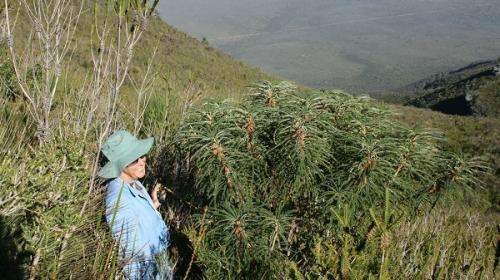CPR for South Coast plants

Department of Parks and Wildlife (DPaW) Flora Conservation Officer Sarah Barrett and FloraTechnical Officer Dylan Lehmann set up a display at this year's Albany Wildflower Exhibition to explain some of the methods being used to protect threatened flora species in the South Coast region.
The South Coast region managed by DPaW covers 1.8 million hectares, with 5 687 known plant taxa. It includes regions of high biodiversity, such as the Fitzgerald River National Park and the Stirling Range National Park, both of which have populations of plants listed as threatened, with many critically endangered.
Ms Barrett and Mr Lehmann explained how recovery plans, in conjunction with South Coast Flora Recovery Teams, are being used to try and prevent the extinction of these plants.
This plan involves demographic monitoring, fire management, fencing, weed eradication, disease management, seed conservation and the translocation and restoration of critically endangered flora.
Phytophthora dieback, caused by the root pathogen Phytophthora cinnamomi, is a threat to many endangered plants in the Stirling Range.
Critically endangered species such as Banksia anatona, Banksia montana, Darwinia collina and Lambertia fairallii have benefited significantly from the practice of aerial spraying with the fungicide phosphite.
This has slowed the decline of these species and bought time for other recovery actions such as seed collection, fencing and translocation.
Coordinated Plant Recovery
CPR, or Coordinated Plant Recovery, is being used by DPaW to help counteract the threat that plant disease, weeds, grazing, inappropriate fire regimes and climate change pose to South Coast plant populations.
The creation of a seed bank at DPaW's Threatened Flora Seed Centre, by collecting and storing the seeds of threatened plants, acts as an insurance policy against their potential extinction.
The seeds can be used for research programmes, such as testing how plants respond to Phytophthora dieback disease, salinity or increased temperature.
Seeds are also used in the translocation and restoration program, where critically endangered plants are reintroduced to the wild.
The DPaW display provided a wonderful extra attraction for the 700 people who attended this year's Wildflower Exhibition. Visitors to Albany were especially interested in learning about the threats to this region's beautiful flora, and all appreciated the obvious enthusiasm that Sarah and Dylan have for their work.
Threatened flora recovery has been supported by the Western Australian and Australian Governments through their threatened species and natural resource management funding via the South Coast Natural Resource Management organisation.
Provided by Science Network WA




















